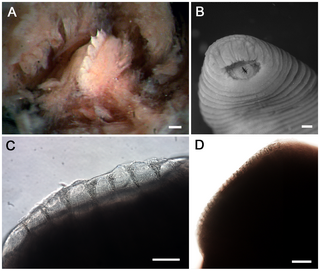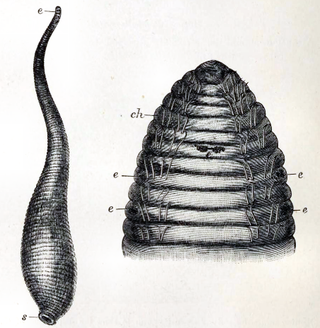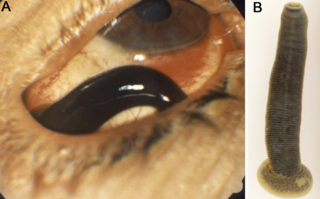
Hirudo medicinalis, or the European medicinal leech, is one of several species of leeches used as medicinal leeches.

Rhynchobdellida, the jawless leeches or freshwater leeches, are an order of aquatic leeches. Despite the common name "freshwater leeches", species are found in both sea and fresh water. They are defined by the presence of a protrusible proboscis instead of jaws, and having colourless blood. They move by "inchworming" and are found worldwide. The order contains 110 species, divided into 41 genera and three families. Members of the order range widely in length, usually between 7 and 40 mm. They are hermaphrodite. The order is not monophyletic.

The Clitellata are a class of annelid worms, characterized by having a clitellum – the 'collar' that forms a reproductive cocoon during part of their life cycles. The clitellates comprise around 8,000 species. Unlike the class of Polychaeta, they do not have parapodia and their heads are less developed.

Haemadipsidae are a family of jawed leeches. They are a monophyletic group of hirudiniform proboscisless leeches. These leeches have five pairs of eyes, with the last two separated by two eyeless segments. The family is monotypic, containing only the subfamily Haemadipsinae, though as the family can apparently be divided into two or three distinct lineages, at least one of the proposed splits, while not a distinct family, might be a valid subfamily.
Erpobdella obscura is a freshwater ribbon leech common in North America. It is a relatively large leech and is commonly used as bait by anglers for walleye and other sport fish. In Minnesota, live bait dealers annually harvest over 45,000 kg of bait-leeches, raising concerns of over-harvest.

Leeches are segmented parasitic or predatory worms that comprise the subclass Hirudinea within the phylum Annelida. They are closely related to the oligochaetes, which include the earthworm, and like them have soft, muscular segmented bodies that can lengthen and contract. Both groups are hermaphrodites and have a clitellum, but leeches typically differ from the oligochaetes in having suckers at both ends and ring markings that do not correspond with their internal segmentation. The body is muscular and relatively solid; the coelom, the spacious body cavity found in other annelids, is reduced to small channels.

The pharynx is the part of the throat behind the mouth and nasal cavity, and above the esophagus and trachea. It is found in vertebrates and invertebrates, though its structure varies across species. The pharynx carries food to the esophagus and air to the larynx. The flap of cartilage called the epiglottis stops food from entering the larynx.

Tyrannobdella is a monotypic genus of leech, of family Praobdellidae, found in South America in the upper reaches of the Amazon. This newly found genus of leech takes sustenance from the mucous membranes of the mammalian upper respiratory tract, and is known to feed upon humans. It has eight teeth. Tyrannobdella rex was discovered feeding upon the mucous membrane of a girl who had recently bathed in the upper Amazon in Peru.

Erpobdella is a genus of leeches in the family Erpobdellidae. Members of the genus have three or four pairs of eyes, but never have true jaws, and are typically 20–50 millimetres (0.8–2.0 in) long. All members do not feed on blood, but instead are predators of small aquatic invertebrates, which they often swallow whole.

Haemopis sanguisuga is a species of freshwater leech in the family Haemopidae. It is commonly called the horse-leech, but that is due to the similarity of its appearance to the leech Limnatis nilotica, which sometimes enters the nasal cavities of livestock. Haemopis sanguisuga does not behave in this way. Another synonym for this leech is Aulastomum gulo.

Hirudo is a genus of leeches of the family Hirudinidae. It was described by Carl Linnaeus in his landmark 1758 10th edition of Systema Naturae.

Babesia canis is a parasite that infects red blood cells and can lead to anemia. This is a species that falls under the overarching genus Babesia. It is transmitted by the brown dog tick and is one of the most common piroplasm infections. The brown dog tick is adapted to warmer climates and is found in both Europe and the United States, especially in shelters and greyhound kennels. In Europe, it is also transmitted by Dermacentor ticks with an increase in infections reported due to people traveling with their pets.

Erpobdella octoculata is a freshwater leech in the Erpobdellidae family. This species can be found in Europe, the Mediterranean, and the Middle East.

The Piscicolidae are a family of jawless leeches in the order Rhynchobdellida that are parasitic on fish. They occur in both freshwater and seawater, have cylindrical bodies, and typically have a large, bell-shaped, anterior sucker with which they cling to their host. Some of the leeches in this family have external gills, outgrowths of the body wall projecting laterally, the only group of leeches to exchange gases in this way.

Acanthobdella peledina is a species of leech-like clitellate in the order Acanthobdellida. It feeds on the skin and blood of freshwater fishes in the boreal regions of northern Europe, Asia and North America.

Piscicola geometra is a species of leech in the family Piscicolidae. It is an external parasite of marine, brackish and freshwater fishes. It was first described as Hirudo geometra by the Swedish naturalist Carl Linnaeus in his Systema Naturae in 1758.

Placobdelloides siamensis is a species of blood-feeding jawless leech in the family Glossiphoniidae. It is commonly known as the Siam shield leech and is a prevalent ectoparasite on Malayemys turtles but has a range of Geoemydidae hosts. In high numbers it can cause severe anaemia and malnutrition which can lead to the death of its host.

Praobdellidae is a family of hematophagous leeches which live on the mucous membranes of mammals and sometimes invertebrates. These are internal parasites that enter the body through natural orifices, and cause hirudiniases.

Dinobdella ferox is a species of leech in the family Praobdellidae. The species is found widely in Southeast Asia and mainly feeds on the mucosal membranes of the mammalian upper respiratory tract. It has been documented to feed on humans.

Macrobdella decora, also known as the North American medicinal leech, is a species of freshwater leech. It is found in much of eastern North America in freshwater habitats, although there is one disjunct population in northern Mexico. M. decora is both a parasite of vertebrates, including humans, and an aquatic predator of eggs, larvae, and other invertebrates.
















